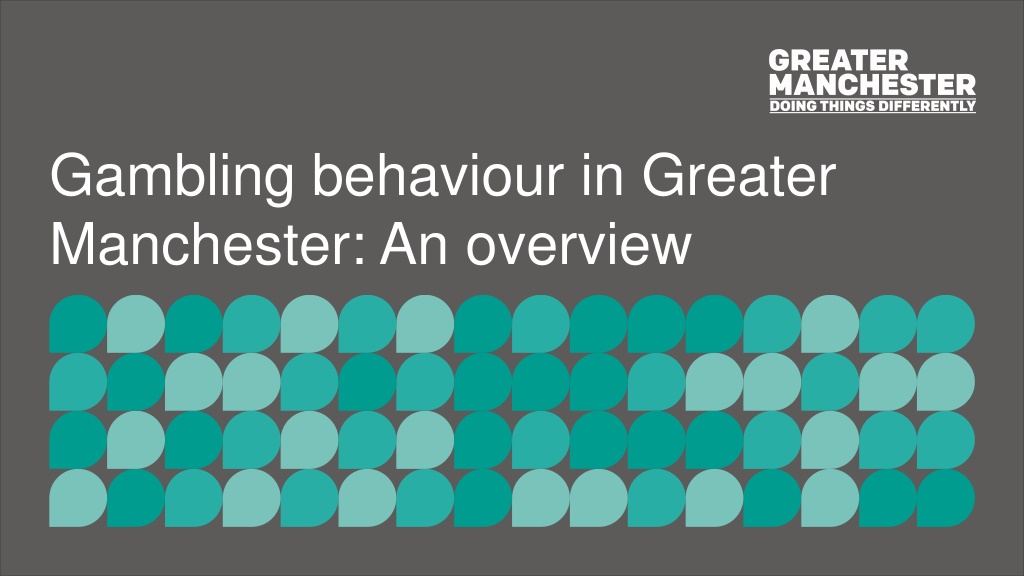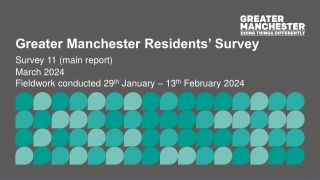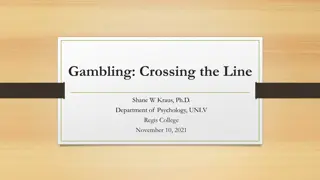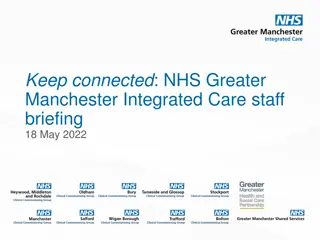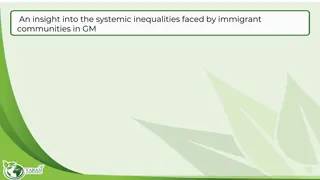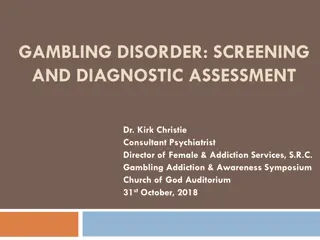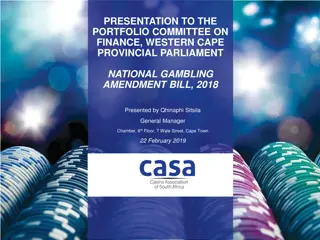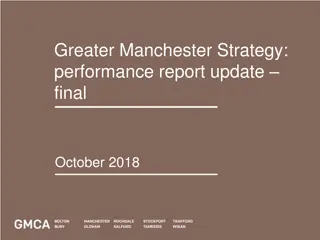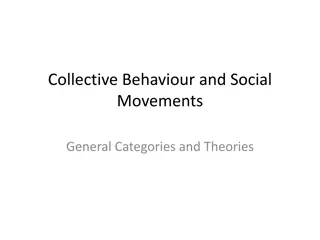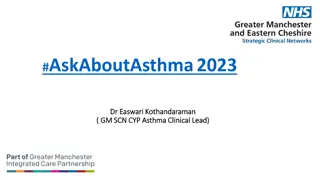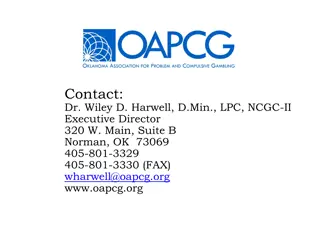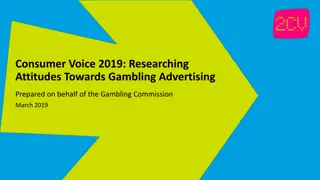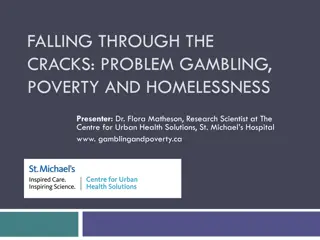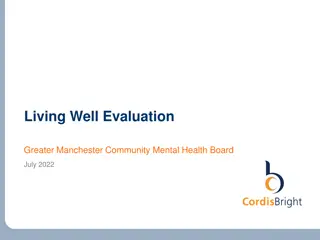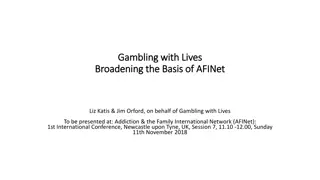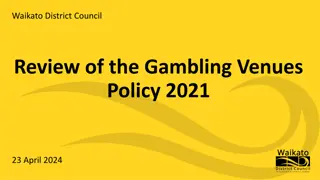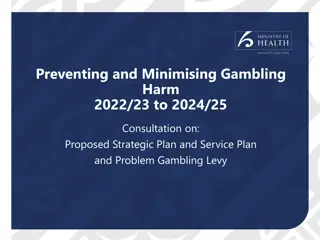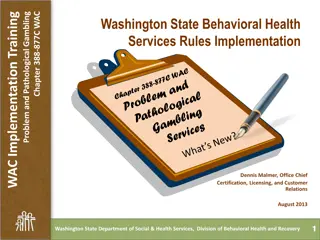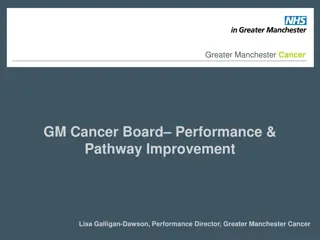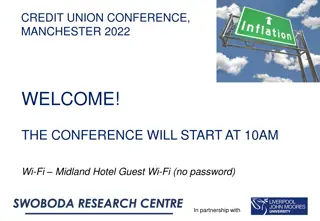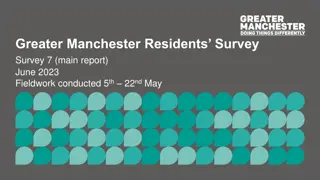Gambling Behaviour in Greater Manchester: An Overview
The Greater Manchester Combined Authority commissioned a study to analyze gambling behaviors among the residents of Greater Manchester using existing survey data from various sources such as the Health Survey for England, GambleAware's Treatment and Support Survey, and the Gambling Commission's Online Tracker Survey. The report delves into the similarities and differences in gambling habits in Greater Manchester compared to other regions in England, shedding light on participation rates, problem gambling severity, and the need for treatment and support. The data from these surveys offer insights into the gambling landscape in Greater Manchester.
Download Presentation

Please find below an Image/Link to download the presentation.
The content on the website is provided AS IS for your information and personal use only. It may not be sold, licensed, or shared on other websites without obtaining consent from the author. Download presentation by click this link. If you encounter any issues during the download, it is possible that the publisher has removed the file from their server.
E N D
Presentation Transcript
Gambling behaviour in Greater Manchester: An overview
About this report The Greater Manchester Combined Authority (GMCA) commissioned a consortium of Dr Heather Wardle, Sarah Tipping and Clare Deverill to use existing survey data to explore whether gambling behaviours in Greater Manchester (GM) are similar or different to those in other places in England To do this, we analysed the following datasets: 1. The Health Survey for England (2015, 2016 and 2018) 2. GambleAware s Annual Treatment and Support Survey (2020) 3. The Gambling Commission s Online Tracker Survey (2015-2019) Introduction
Disclosures Heather Wardle declares that she receives funding from the ESRC, National Institute of Health Research, Wellcome, Department for Digital Culture Media and Sport and the Gambling Commission. In 2018/19 she worked on one project for GambleAware looking at gambling and suicide. She was Deputy Chair of the Advisory Board for Safer Gambling for five years, remuneration provided by the Gambling Commission Sarah Tipping and Claire Deverill have nothing to declare. This report should be cited as: Wardle H, Tipping S, Deverill C.(2022) Gambling Behaviour in the Greater Manchester Combined Authority: An overview. GMCA. Introduction
Part 1 About the data Gambling behaviour in Greater Manchester: An overview
The Health Survey for England The Health Survey for England (HSE) is a nationally representative survey of people living in private households in England. Each year around 8,000 adults aged 16 and over take part. HSE has national statistics status and provides official statistics to government on obesity and smoking. In 2015, 2016 and 2018 questions about past year participation in 17 forms of gambling were included in the survey along with the Problem Gambling Severity Index (PGSI) and the measurement of gambling problems using the DSM-IV, which produce estimates of experience of problem gambling. Combining survey responses from 2015, 2016 and 2018 provided a sample of 1,224 people living in GM, allowed us to look at gambling participation and problem gambling among those living in GM. Part 1. About the data
GambleAware Treatment and Support Survey The GambleAware Treatment and Support Survey (GATSS) is a now annual online survey run by GambleAware. They recruit people from YouGov s online panel of over 1million people living in Britain. In 2020, 16,401 people living in England took part, including 1,342 people living in GM. Online panels tend to over-report risky behaviours compared with gold-standard random probability methods, which has also been shown to be the case with gambling. As such, results from the HSE should be considered more representative than those from this survey. The survey asked a fuller range of questions about gambling behaviours and need for treatment support than the HSE. It also includes measurement of gambling problems using the PGSI. Nonetheless, this survey allows us to look at gambling patterns among those living in GM vs those living in other areas. Part 1. About the data
Gambling Commission Online Tracker Survey The Gambling Commission s online tracker collects information from around 4,000 people per year on their gambling behaviours. These people are recruited from Yonder s (formerly Populus) online panel. For this project we combined data collected in 2015 to 2019 to create a sample of 1,747 people who live in GM. This survey collects a range of information about online gambling behaviours and uses a short-form of the PGSI to measure gambling problems. As before, online panels tend to over-report risky behaviours compared with gold-standard probability methods, which has also been shown to be the case with gambling. Additional methodological issues with this sample were identified, such as some panellists being interviewed twice in the same year. As such, results from HSE should be considered more representative than those from this survey. Part 1. About the data
Part 2 Analytical approach Gambling behaviour in Greater Manchester: An overview
GM, urban areas and other areas For each study, we identified people living within GM We then calculated levels of gambling participation and problem gambling, by gender, for the following groups: those living in GM those living in other urban areas those living in non-urban areas As the GM is a large urban area, we wanted to see how similar or different gambling behaviours were to those living in other urban areas and those living in non-urban areas The Gambling Commission study defined urban areas (comparing major urban areas with others) differently from HSE and the GATSS (comparing all urban areas with non-urban areas)* *see individual reports for more details for this reason, along with data quality, some analyses are restricted to HSE and GATSS Part 2. Analytical approach
Analysis by Local Authority area Only the HSE had sample sizes large enough to explore potentially looking at analysis for each Local Authority (LA) within the GMCA Investigation of this showed that the number of people interviewed in each LA ranged from 195 in Manchester to 66 in Rochdale These sample sizes are not sufficient to be able to produce robust and meaningful analysis for each LA In particular, estimates of problem gambling by LA could be misleading. Only 121 people within the combined HSE data experienced problem gambling with sample sizes as small as 66 people, it may be likely that no problem gamblers were sampled from areas like Rochdale. This doesn t mean than problem gambling is not a issue for Rochdale, but rather that the survey hasn t interviewed enough people to be able to pick this up. Part 2. Analytical approach
Part 3 Key findings Gambling behaviour in Greater Manchester: An overview
Do people living in GM gamble more or less than others? All three surveys showed that: People living in GM (and other urban areas) were more likely than those living in non-urban areas to have gambled on five or more different gambling activities Frequency of gambling was only captured in the HSE and GA Treatment and Support (GATSS) survey which showed that: Adults living in GM gambled more frequently than those living in non-urban areas (HSE: 16.6% for GM vs 8.7% for non-urban gambling twice a week or more; GATSS: 20.3% for GM vs 15.9% for non-urban gambling twice a week or more) Patterns of past year gambling on any activity were mixed: In HSE, those living in GM were less likely to have gambled in the past year than those in non-urban areas. For the GATSS and the Gambling Commission Online Tracker rates of past year gambling were higher within GM than other areas Taken together, there appears to be a higher level of engagement in gambling, gambling on more things, more often, among those who live in GM than those who live in non-urban areas. Focus on patterns of past year participation alone masks these differences. These patterns were the same for men and for women Part 3. Key findings
Do people living in GM gamble more or less than others? (contd.) Figure 1. Proportion of respondents gambling on five or more activities, by survey and area type Figure 2. Proportion of respondents gambling on two or more days per week, by survey and area type 25 25 21.2 21.1 20.3 19.4 18.8 20 20 17.9 16.6 16.1 Proportion (%) Proportion (%) 15.9 15 15 12.2 11.8 8.7 10 10 5.5 5.5 5.3 4.2 3.9 5 5 2.7 2.4 1.7 0 0 HSE GATSS GC HSE Gambled on 2 or more days a week GATSS Gambled on 5 or more activities GM Urban areas Non-urban areas England average GM Urban areas Non-urban areas England average Part 3. Key findings
Do people living in GM gamble on different things? Data from the HSE and GATSS were used to look at whether people living in GM were more or less likely to gamble on certain activities* Whilst the activities asked about were different in each survey, there were some commonalities. Both studies showed that people living in the GMCA (and other urban areas) were more likely to report gambling on: Bingo Machines in bookmakers Betting on sports events Only HSE measured online gambling on any form of activity: people living in GM were more likely to gamble online (10.2%) than those living in non-urban areas (8.9%). Rates in GM were higher than the national average (9.4%) HSE data also showed that people living in the GM (and other urban areas) were less likely to gamble on lotteries and to bet at a bookmakers on horses. The GATSS showed that people in urban areas were less likely to gamble on other lotteries The GATSS data also suggested greater engagement in scratchcards, slot machines, and gambling at a casino whereas HSE suggested greater engagement in football pools and spreadbetting among those living in the GM** *This analysis was not conducted on the Gambling Commission data because of issues with sampling quality; ** The GATSS study did not ask about football pools or spread-betting and the way gambling in a casino was described to participants varied between studies: in HSE it was called table games at a casino; in GATSS it was described as gambling at a casino, which could include slot machines or electronic roulette along with casino table games. Part 3. Key findings
Gambling activities by area type Figure 3. Proportion of respondents gambling on machines in bookmakers (formerly FOBTs), by survey and area type Figure 4. Proportion of respondents gambling online, by area type 10.5 10.2 3.5 3 2.9 10 2.8 3 Proportion (%) 9.5 2.5 Proportion (%) 9.4 9.5 2 2 8.9 9 1.3 1.5 1.1 1 1 8.5 0.4 0.5 0 8 HSE GATSS HSE Gambled on machines in bookmakers (FOBTs) Online gambling GM Urban areas Non-urban areas England average GM Urban areas Non-urban areas England average Part 3. Key findings
Do people living in GM experience more or less problem gambling? All three surveys showed that people living in GM (and other urban areas) were more likely to experience problem gambling than those living in non-urban areas: HSE: 0.8% vs 0.3% GATSS: 2.9% vs 1.4% Gambling Commission: 6.2% vs 3.9% In all studies, estimates of problem gambling in GM were slightly higher than the national average These patterns were broadly similar for men and women, though HSE analysis is based on a limited number of women and estimates should be treated with caution Part 3. Key findings
Do people living in GM experience more or less gambling harms? (contd.) Gambling harms are the the adverse impacts from gambling on the health and wellbeing of individuals, families, communities and society (Wardle et al, 2019). Gambling can affect people s resources, relationship and health and wellbeing. It is recognised that harms, that is negative consequences from gambling, are broad-ranging (Langham et al, 2016) and that people may experience these things without necessarily experiencing problematic gambling. Research shows that those with PGSI score of less than 8 still report harms from gambling. Building on this, researchers in Canada have analysed responses to PGSI in a different way by focusing on endorsement of seven out of the nine item which relate to the experience of negative consequences from gambling (i.e., problems with health; financial difficulties, feelings of guilt/shame etc). Using this, they state that those who report two or more of these consequences experience harms from gambling (Young et al. 2021) HSE data shows that 3.3% of all people living in GM area experienced at least one negative consequence from gambling. That s around one in thirty people. Around 1.7% experienced direct harms from gambling, that s around one in sixty people. Direct experience of harms was higher in GM than those living in non-urban areas (0.7%) and slightly higher than the national average (1.5%). Part 3. Key findings
Do people living in GM experience more or less gambling harms? (contd.) Figure 5. Problem gambling prevalence according to the PGSI, by survey and area type Figure 6. Direct gambling harms according to the PGSI, by area type 1.7 1.8 1.6 7 6.5 1.5 1.6 6.2 1.4 6 Proportion (%) 4.8 1.2 5 Proportion (%) 3.9 1 4 0.7 0.8 2.9 2.6 3 2.4 0.6 2 1.4 0.4 0.7 1 0.5 0.5 0.2 0.2 0 0 HSE Problem gambling according to the PGSI GATSS GC HSE Gambling harms according to the PGSI GM Urban areas Non-urban areas England average GM Urban areas Non-urban areas England average Part 3. Key findings
Is GM different from other urban places? Generally, patterns of gambling among people living within GM are similar to those living in other urban areas This is especially true for estimates of gambling harms and problematic gambling, where rates within GM and other urban areas were very similar across all surveys There were some differences in some measures of gambling participation in some surveys but there was no consistent pattern across all surveys to suggest that patterns of participation were strikingly different in GM to other urban areas In short, GM, as a major urban area, displays similar gambling patterns to other urban places in that people gambling more often, on more things and have a higher degree of harm than those living in non-urban places Part 3. Key findings
Why do we see these patterns? People living in urban places have a different demographic and socio-economic profile to those living in non-urban places. They tend to be young and have higher educational qualifications. Urban places also include some of the most deprived areas in England. These factors are associated with experiences of gambling harms. Multi-variate logistic regression was used to test whether these factors influence the association between urban residents and problem gambling. This tested whether urban residence was still associated with problem gambling once age, sex, ethnic origin, marital status, educational attainment, income, social class and area deprivation were taken into account. Results showed that living in urban areas (including GM) was significantly associated with problem gambling, even after adjusting for all these things. The odds of experiencing problem gambling were 2.1 times higher among those living in urban places than those who do not. Whilst the different demographic and socio-economic profile of those living in urban areas explains some of the association between urban residence and problem gambling, it does not explain it all. Other factors, like different gambling preferences, behaviour and availability may also be important. Part 3. Key findings
Part 4. Conclusions Gambling behaviour in Greater Manchester: An overview
What does this mean for Greater Manchester? People living in GM, like other urban areas, have higher rates of problem gambling and experience of gambling harms than those living in other places The HSE provides the most robust, though conservative, measure of gambling harms: in GM at least 0.8% of residents experience problem gambling, 3.3% experience at least one negative consequence of gambling and 1.7% experience direct harms. Those living in the GM gamble more often and on more things than those not living in urban places both are associated with higher risk of harms Those living in the GM are more likely to gamble on activities associated with higher risk of harms: namely online gambling and gambling on machines These estimates only include those experiencing problem gambling or harms directly they do not include harms experienced by affected others. Research estimates that a problem gambler negatively effects 6 other people (Goodwin et al, 2017). Applying this to the estimated number of people experiencing problem gambling in the GM (8 per 1000), means that further 48 per 1000 people living in the GM may be affected by someone else s gambling that equates to around 5% of people living in GM. Part 4. Conclusions
Part 5. References Gambling behaviour in Greater Manchester: An overview
References Goodwin, B.C. et al. (2017) A typical problem gambler affects six others , International Gambling Studies, 17 (2), pp. 276 289. Langham, E. et al. (2016) Understanding gambling related harm: a proposed definition, conceptual framework, and taxonomy of harms , BMC Public Health, 16 (1), p. 80. Wardle, H. et al. (2019) Gambling and public health: we need policy action to prevent harm , BMJ, 365, p. l 1807. Young, M.M. et al. (2021) Developing Lower-Risk Gambling Guidelines. Summary Report. Ottawa, Ontario: Canadian Centre on Substance Use and Addiction. Available at: https://gamblingguidelines.ca/resource/developing-lower- risk-gambling-guidelines-report/. Part 5. References
